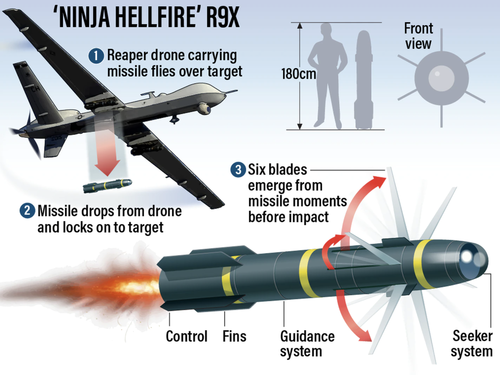al-Zawahiri Shredded By Blades Of Non-Explosive “Flying Ginsu” Missile
Al Qaeda leader Ayman al-Zawahiri wasn’t blown up at his Kabul residence over the weekend — he was apparently butchered on his balcony with the blades of a “flying Ginsu,” a nickname for a special type of Hellfire missile used in highly-targeted strikes.
Because a conventional explosive warhead would have risked killing nearby civilians, the CIA is believed to have used the little-known R9X, which deploys six long blades seconds before impact and slices its victim into bloody chunks.
It was a poetically fitting end for a former surgeon who became one of the principal architects of 9/11.
Moving at 1,000 miles per hour, the blades of the R9X can reportedly slice through concrete and steel. However, with Zawahiri perched on his breezy balcony, the blades were completely unimpeded when they struck the 71-year-old Egyptian at 6:18 am Kabul time on Sunday.
National Security Council spokesman John Kirby told CNN the U.S. has visual confirmation of Zawahiri’s death, but no DNA confirmation. He said nobody else was killed in the attack, which used two Hellfire missiles. The lack of damage to the building is striking:
A photo said to show the balcony where Zawahiri was killed on Sunday (Twitter)
The missile’s nickname was inspired by the directly-marketed Ginsu kitchen knife, which rose to fame in the late 1970s thanks to frequent television commercials showing the knife being used to cut through metal cans, wood other material.
The R9X’s existence was first reported by The Wall Street Journal in 2019. At the time, it had only been used roughly a half-dozen times. A similar version has no blades, but rather plunges over a hundred pounds of metal through the roofs of cars or buildings at Mach 1.3. An official told the Journal that, to the targeted individual, it’s like being hit by a speeding anvil.
The aftermath of a suspected non-explosive Hellfire strike in Aleppo, Syria in 2020 (via @obretix)
Given its non-explosive nature, the R9X requires unusually accurate targeting data. In the case of Zawahiri, the CIA had that in spades. Before killing Zawahiri, the CIA had monitored him for months, as he lived in a wealthy Kabul neighborhood that was previously home to many Western embassies.
The CIA found Zawahiri by monitoring his family members who moved into the same Kabul residence. “Multiple streams of intelligence” persuaded analysts that they’d found Zawahiri, a senior official told the Associated Press.
R9X missiles have been deployed a number of times by JSOC in NW #Syria to target senior #AlQaeda figures — they’re extraordinarily precise & have worked to great effect until now.
See here, for example, from June 2020.
I’ve not seen one used on a building before, though. pic.twitter.com/eLvY35tlZ5
— Charles Lister (@Charles_Lister) August 1, 2022
Once they discovered him, analysts painstakingly catalogued his “pattern of life.” Part of that pattern included his enjoyment of the balcony on “multiple occasions, for sustained periods of time,” the senior official said.
The planning of Zawahiri’s execution took place under the shadow of a disastrous American drone strike during the withdrawal of U.S. troops that killed 10 innocents, including seven children. With a high priority on minimizing casualties, preparations for the Zawahiri’s killing included engineering studies of the building where he lived.
Senior officials were first briefed on the pinpointing of Zawahiri in early April, and President Biden soon thereafter. On July 1, the CIA briefed Biden on his options, with a presentation that included a scale model of the house.
This is believed to be the house in central Kabul where Al Qaeda leader al Zawahiri was staying & killed in a US drone strike, (another location apparently also hit)
Taliban preventing media getting close, insisting there’s nothing to see, but we & others had guns pointed at us pic.twitter.com/2iJKKGPzat
— Secunder Kermani (@SecKermani) August 2, 2022
None of the reporting indicates that an option to capture Al Qaeda’s leader was discussed, even though an interrogation would have the potential to yield valuable intelligence. On the other hand, with the prosecution of Khalid Sheikh Mohammed and other alleged 9/11 co-conspirators still not in the trial phase 21 years after their crimes, there was probably very little appetite to add a new defendant.
Another factor likely weighed more heavily against an attempted apprehension of the mass murderer of thousands of Americans: Zawahiri’s interrogations, depositions and trial testimony could implicate members of the Saudi royal family who’ve bankrolled al Qaeda since its inception, as well as Saudi diplomatic officials whose apparent support of two 9/11 hijackers has been detailed in recently-declassified FBI files.
Saudi Crown Prince Mohammed bin Salman welcomes Biden to Riyadh on July 15 (Saudi Press Agency/AP)
…to say nothing of what he might say about the CIA.
Tyler Durden
Wed, 08/03/2022 – 09:20

